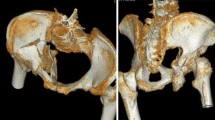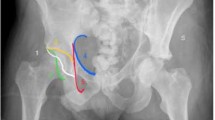Abstract
Acetabular fractures are complex lesions and they require anatomical surgical reduction in order to achieve satisfactory results in long-term follow-up. Some risk factors are associated with unfavourable results and have confirmed that older patients with acetabular fractures have worse outcomes than younger patients. Total hip replacement after an acetabular fracture generally produces good clinical results; however, in some contexts it must be combined with correct stable fixation of the fracture. The type of fracture and overall patient conditions influence the choice of the surgical technique and, consequently, the type of healing to lead to a satisfactory result.



Similar content being viewed by others
Bibliografia
Laird A, Keating JF (2005) Acetabular fractures: a 16 year prospective epidemiological study. J Bone Jt Surg, Br 87:969–973
Giannoudis PV, Grotz MR, Papakostidis C, Dinopoulos H (2005) Operative treatment of displaced fractures of the acetabulum. A meta-analysis. J Bone Jt Surg 87:2–9
Butterwick D, Papp S, Gofton W et al. (2015) Acetabular fractures in the elderly: evaluation and management. J Bone Jt Surg, Am 97:758–768
Daurka JS, Pastides PS, Lewis A et al. (2014) Acetabular fractures in patients aged >55 years: a systematic review of the literature. Bone Jt J 96:157–163
Letournel E (1980) Acetabulum fractures: classification and management. Clin Orthop Relat Res 151:81–106
Matta JM (1996) Fractures of the acetabulum: accuracy of reduction and clinical results in patients managed operatively within 3 weeks after the injury. J Bone Jt Surg, Am 78:1632–1645
Moed BR, Yu PH, Gruson KI (2003) Functional outcomes of acetabular fractures. J Bone Jt Surg, Am 85:1879–1883
Meena UK, Tripathy SK, Sen RK et al. (2013) Predictors of postoperative outcome for acetabular fractures. Orthop Traumatol, Surg Res 99:929–935
Manson T, Schmidt AH (2016) Acetabular fractures in the elderly: a critical analysis review. J Bone Jt Surg Rev 4(10):27792674. https://doi.org/10.2106/JBJS.RVW.15.00090
De Bellis UG Legnani C, Calori GM (2014) Acute total hip replacement for acetabular fractures. A systematic review of the literature. Injury 45:356–361
Zinghi GF, Pascarella R (2012) Acetabolo—Lesioni Traumatiche—Dall’urgenza al trattamento programmato. Timeo, Bologna
Olson SA, Matta JM (1993) The computerized tomography subchondral arc: a new method of assessing acetabular articular continuity after fracture (a preliminary report). J Orthop Trauma 7(5):402–413
Author information
Authors and Affiliations
Corresponding author
Ethics declarations
Conflitto di interesse
Gli autori Raffaele Pascarella, Simone Cerbasi, Pasquale Sangiovanni, Rossana Fantasia, Rodrigo Buharaja, Rosella De Marco, Mariastella Riccardi, Mario Arduini dichiarano di non avere alcun conflitto di interesse.
Consenso informato e conformità agli standard etici
Tutte le procedure descritte nello studio e che hanno coinvolto esseri umani sono state attuate in conformità alle norme etiche stabilite dalla dichiarazione di Helsinki del 1975 e successive modifiche. Il consenso informato è stato ottenuto da tutti i pazienti inclusi nello studio.
Human and Animal Rights
L’articolo non contiene alcuno studio eseguito su esseri umani e su animali da parte degli autori.
Rights and permissions
About this article
Cite this article
Pascarella, R., Cerbasi, S., Sangiovanni, P. et al. Gestione e trattamento delle fratture acetabolari. LO SCALPELLO 33, 23–29 (2019). https://doi.org/10.1007/s11639-019-00305-3
Published:
Issue Date:
DOI: https://doi.org/10.1007/s11639-019-00305-3




